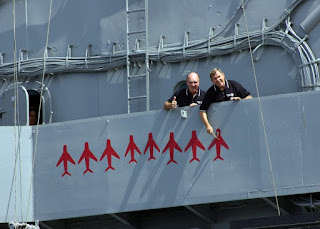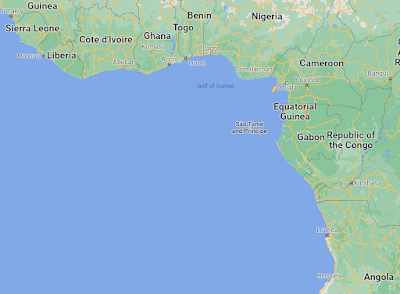This week, navalists everywhere are having fun with the comments by Secretary of the Army Christine Wormuth at Center for Strategic and International Studies back on December 1st.
First of all ... let's go to the map room.
What? Not clear enough? Let me help.
Over on twitter, I promised a thorough fisking of her comments ... so here we go.
"A more powerful Chinese military helps to underwrite Beijing's strategy to achieve the 'great rejuvenation of the Chinese nation' by 2049 — to include development of the PLA [People's Liberation Army] into a 'world class military' by midcentury,"
"China's focus on modernizing its military capabilities will strengthen its ability to coerce Taiwan and rival claimants in territorial disputes, project power globally, and counter interventions along the PRC's [People's Republic of China] periphery," she said.
First of all, besides those forces trained and equipped for amphibious operations, the People's Liberation Army is mostly a concern of the Indians and Russians ... with the Vietnamese a close third. We have no concerns with China on the Asian landmass as long as they keep their forces out of the Korean peninsular.
Right now, the Chinese military is manned with about two million service members — 975,000 of them in army combat units. It also has the most ships of any navy in the world, Wormuth said. And within the Indo-Pacific region, the Chinese military also has the largest air force.
Huh. That sounds to me like we should allocate more funds to address <checks notes> naval forces to counter their expanded capabilities at sea.
China now has the ability to attack U.S. sensors and communication links in space and also has missiles that can sink U.S. ships and take down aircraft, Wormuth said.
"They have missiles that can reach U.S. bases in Japan and Guam, exposing our planes and runways to attack," she said. "Not only does China have advanced precision weapons, it has them in large and growing quantities. And just recently, China conducted a missile test that sent a missile around the world, dropping off a hypersonic vehicle that glided all the way back to China where it then struck a test target."
So, what you're saying is that static, land based assets are a bad idea due to their vulnerability? Maybe it wouldn't be a bad idea to perhaps allocate more funds for mobile, sea-based solutions? Yes? Solid thinking Madam Secretary.
Considering the advancements made by the Chinese military and the challenges it poses to the U.S., Secretary of Defense Lloyd J. Austin III has identified China as a "pacing challenge" for the Defense Department.
In the name of all that is holy, there is nothing "pacing" about the challenge from China. Anyone who uses this word calls their credibility in to question. If anything they are accelerating, passing, or lapping us.
"In my view, the Army will have at least five core tasks if a conflict breaks out, and these are tasks the Army can usefully perform without presuming substantial expansion of Army permanent presence in the region in the near term future," Wormuth said.
Five, as in the numbers of fingers on a hand? Nice. We can hold track on that.
First, she said, the Army will serve as the 'linchpin" service within the joint fight.
Oh no, not "linchpin." As in the thing that needs to be removed in order to make a grenade useful in combat?
This isn't going to go well, is it?
"The Army will establish, build up, secure and protect staging areas and joint operating bases for air and naval forces in theater," Wormuth said. "We will be prepared to provide integrated air and missile defense, both for fixed sites and using mobile elements. We will provide area security and quick reaction forces where needed."
So, should we disregard previous comments about the vulnerability of static, shore based infrastructure, or no? Is this just a way to give PLA rocket forces more targets in the hope we'll confuse them? Also ... about those bases, you may want to review 10 U.S. Code § 8063 - United States Marine Corps: composition; functions. It states;
The Marine Corps shall be organized, trained, and equipped to provide fleet marine forces of combined arms, together with supporting air components, for service with the fleet in the seizure or defense of advanced naval bases and for the conduct of such land operations as may be essential to the prosecution of a naval campaign.
Not your job Army.
The Army will also use its vast logistics capacity to sustain joint force partners across the Indo-Pacific region, she said.
With what resources will you go from island to island, exactly? Remember, this is WESTPAC, not EUCOM. No choo-choos.
"The Army, for example, will provide much of the secure communication network background. We will generate intra-theater distribution networks to keep the joint force supplied from dispersed locations, and we will maintain munition stockpiles and forward arming and refueling points," she said.
How many times has the Army done this with multiple maritime formations at sea or for that matter integrated long distance air campaigns? With the Army having the lead in AFG and IRQ recently, do they instill confidence they are ready for this as the supported service? Really?
The Army can also provide command and control capability at multiple levels to ensure coordination and synchronization across the joint force.
"The Army, with its substantial planning and operations capacity at the division and corps level, is uniquely well placed to provide command and control for the joint force," Wormuth said.
As mentioned earlier ... this is a maritime and aerospace fight. The Army is not well placed at all.
Beyond just mission support, Wormuth also said the Army brings substantial combat capability to the joint force. For instance, she said the Army will provide ground-based, long-range fires to enhance the joint force’s strike capability.
They will? Please, bring me the map with your range rings.
"Using our long-range hypersonic weapons, mid-range capability and precision strike missiles — all of which we will begin fielding in fiscal year 2023 — we will be able to interdict fires across sea lines of communication, suppress enemy air defenses and provide counter fires against mobile targets."
IOC in 2023? Is that in combat effective numbers? By then end of FY25, how many warshots will be in theater? Those will serve how many targets? What is the monthly production capacity for replacement rounds?
Finally, she said, the Army can provide counter-attack capability using its maneuver forces. Infantry stryker elements or combat aviation brigades, for instance, can be used to restore territorial integrity of allies and partners.
Wait ... bring those maps back. Where outside Korea on the Asian landmass are you planning to insert those mechanized forces?
While Wormuth said the Army is currently capable of providing such capabilities to the joint force without changes in its existing permanent presence in Indo-Pacom, some changes would be useful. Right now, the U.S. military footprint in Asia is oriented towards the northeast, in places like Japan and Korea, for instance.
Like ... now? Really? "Currently" is doing a lot in this paragraph. Should we wargame JUN2022 or no?
"I think there is very much a desire to be able to expand our access and basing arrangements more into Southeast Asia; because, if we were able to do that, we would have ... a more dispersed posture that would give us much more flexibility," she said. "I think it is very much in our interest, and in the interest of our allies and partners, to explore how we can shift that posture over time."
What are we talking about here, Vietnam? Malaysia? Indonesia? Thailand? Who is willing to let the US Army put a flagpole down?
Nevertheless, considering where the U.S. operates now in Asia, she said it's important to maintain realistic assumptions about where the U.S. will be operating from, at least in the near future.
"Realistic." Indeed. May want to review previous comments.
"The Indo-Pacific ... is a region of great opportunity for the United States, but also real challenges," she said. "The Army is stepping up to that challenge, both in terms of how we contribute to the country’s ability to compete with China and our ability to deter coercion and aggression in the region."
Yes, the Army has a role, and important role, in any fight west of Wake, but not as the lead. They are no more the lead for the Pacific than the US Navy would be in Ukraine. They are the supporting, not the supported service.
Unless you are planning to restart a drive up the Korean peninsular or reinforce India on her border with China, the Army should not be even pondering the lead.
Geography, history, national comparative advantage all tell us this is a maritime and aerospace battle. Any plan that includes engaging our Army in any significant force level on the Asian mainland is to invite national ruin.























